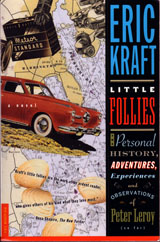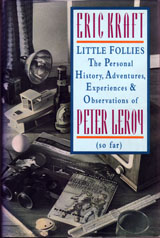

| Little Follies
Do Clams Bite? Chapter 10: “Kill Him!” |
by Eric
Kraft, as Peter
Leroy
|

YOU CAN READ THE FIRST HALF
YOU CAN ORDER THE
|
“Kill him!” Grandfather shouted. A family, fifty yards or so off starboard, looked up at this shout. They had a small motorboat anchored in the flats. The father was doing some clamming, using a rake. The mother was sunning on the tiny deck forward. Two children were paddling around in inner tubes. “OK!” called my father. He grabbed a screwdriver and shorted the spark-plug lead to the block. He coughed a couple of times and died. I let out a scream and fell to the deck in the cockpit. “What are you up to, Peter?” asked my father. “He’s dead,” he called out to Grandfather. I raised myself on one elbow and peeked over at the family. Father and the children were scrambling for the boat. Mother was tugging at the anchor line. Soon they were planing toward the mainland, ahead of a wide, white wake, and we had a broad expanse of the flats to ourselves. |
 |
||||
| ..... | .......... | .......... | ..... |

Here are a couple of swell ideas from Eric Kraft's vivacious publicist, Candi Lee Manning: Tip the author.
Add yourself to our e-mailing list.
|
Little Follies is a work of fiction. The characters, incidents, dialogues, settings, and businesses portrayed in it are products of the author’s imagination and are not to be construed as real. Any resemblance to actual events or persons, living or dead, is entirely coincidental. All rights reserved. No part of this book may be reproduced or transmitted in any form or by any means, electronic or mechanical, including photocopying, recording, or by any information storage and retrieval system, without permission in writing from the author. “My Mother Takes a Tumble,” “Do Clams Bite?,” “Life on the Bolotomy,” “The Static of the Spheres,” “The Fox and the Clam,” “The Girl with the White Fur Muff,” “Take the Long Way Home,” and “Call Me Larry” were originally published in paperback by Apple-Wood Books. Little Follies was first published in hardcover by Crown Publishers, Inc., 201 East 50th Street, New York, New York 10022. Member of the Crown Publishing Group. YOU CAN ORDER THE
For information about publication rights outside the U. S. A., audio rights, serial rights, screen rights, and so on, e-mail the author’s imaginary agent, Alec “Nick” Rafter. The illustration at the top of the page is an adaptation of an illustration by Stewart Rouse that first appeared on the cover of the August 1931 issue of Modern Mechanics and Inventions. The boy at the controls of the aerocycle doesn’t particularly resemble Peter Leroy—except, perhaps, for the smile. |
|
||||||
| . | . |